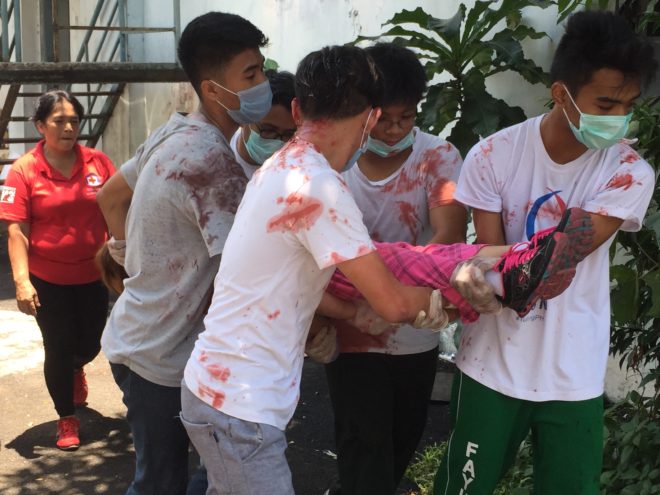Visit us on Instagram To be You; Facebook: To be You; e-mail inq.tobeyou@gmail.com

As a big fan of “Grey’s Anatomy,” I’ve always dreamed of learning CPR (cardiopulmonary resuscitation) and to experience what it’s like to be a medical responder on the field.
More than just the drama in the medical field, what I really love about “Grey’s” is that when disaster strikes in rainy Seattle, the doctors and medical responders almost always come through at the end of the day.
So, when the opportunity to become a Red Cross volunteer presented itself, I jumped at the chance to live my dream.
But first I had to go through the Red Cross Occupational First Aid and Lay Rescuers seminar. I still remember the moment we were handed our participant kits and the instructor, Rodino Cruz, walked in. It felt surreal.
But I was so into it, I couldn’t care less even if each session was seven to eight hours long, and packed with the vital information I needed to pass the course.
Learning CPR
After giving a brief historical background of Red Cross, Cruz discussed its services, its seven fundamental principles, and the Red Cross emergency number, 143.
Then he went straight into the nitty-gritty of basic first aid, some common illnesses, and how to size up and assess an emergency situation.
The highlight was on the discussion of performing hands-on CPR and learning all the intricacies of assessing whether or not a person needs it, and the tedious but delicate act of kneeling and executing at least 15 cycles of 30 compressions on the Red Cross CPR dummy to master this important life-saving skill.
One lasting impression was stressing the importance of blood donations, and the scarcity of blood donors today because of many misconceptions. The truth is, Red Cross promotes state-of-the-art technology that ensures safe, adequate and quality blood supply to save the lives of patients—which could very well be your own life in the future.
Common sense
We also got to learn about common emergencies, such as bleeding, wounds and burns. We learned about emergency preparedness and how to respond to extraordinary situations such as earthquakes or fires, and how to handle drills.
We learned dozens of bandaging techniques for different types of injuries, and how to perform emergency lifts and moves.
What really struck me was the importance of applying common sense during intense situations. During our practical exam, we committed mistakes in bandaging and lifting that could have been avoided had we not been under pressure.
Cruz emphasized that the most important thing about being a first-aider is to stay calm and think clearly to treat the victim in the best way possible.
D-Day
The seminar’s final day was the most exciting of all sessions. We joined other aspiring volunteers at the Red Cross Quezon City chapter office to take our “final exam” and participate in a simulated mass casualty incident (MCI).
We learned about the different jobs and teams that are crucial in an MCI. We were assigned either as rescuers, first-aiders or documenters (I joined the third one).
Once the simulation started, chaos ensued as rescuers scampered around carrying the MCI victims to the makeshift treatment area. “Blood” was literally all over the place.
We had to treat stab wounds, lacerations, burns and even help a “pregnant” woman deliver her child. Because of the commotion, I did not even notice that I actually suffered a cut in my arm while trying to “save lives.”
It was like we were all in our own “Grey’s Anatomy” episode, performing the very same tasks that I have watched countless doctors do to save their patients’ lives.
Saving lives is for everyone
Seeing different people from different age groups and all walks of life working together toward completing a virtual rescue mission surprised me. It made me look back to the first session and my uncertainty of attending the seminar because I thought I would be the only 16-year-old interested in first aid.
Seeing strangers communicating and working together on even the simplest tasks proved that, when it comes to saving lives, anyone can and must do the right thing.
Saving lives seems a big task only for doctors like my “Grey’s Anatomy” heroes, Meredith Grey and Derek Shepherd. But I found out that being a Red Cross Youth volunteer can also go a long way in helping save real lives one day, maybe even tomorrow. —CONTRIBUTED
(After attending the Red Cross seminar, the author has embraced her role as Red Cross Youth (RCY) ambassador hoping to convert more students all over the country into life savers.)
For those interested to become RCY volunteers, e-mail the author at juliaRCYph@gmail.com